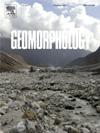Inventory of active rock glaciers and their distribution characteristics on the Qinghai-Tibet Plateau and its adjacent mountainous regions
IF 3.1
2区 地球科学
Q2 GEOGRAPHY, PHYSICAL
引用次数: 0
Abstract
With the global climate change, glaciers on the Qinghai-Tibet Plateau (QTP) and its adjacent mountainous regions are retreating rapidly, leading to an increase in active rock glaciers (ARGs) in front of glaciers. As crucial components of water resources in alpine regions and indicators of permafrost boundaries, ARGs reflect climatic and environmental changes on the QTP and its adjacent mountainous regions. However, the extensive scale of rock glacier development poses a challenge to field investigations and sampling, and manual visual interpretation requires substantial effort. Consequently, research on rock glacier cataloging and distribution characteristics across the entire area is scarce. This study statistically analyzed the geometric characteristics of ARGs using high-resolution GF-2 satellite images. It examined their spatial distribution and relationship with local factors. The findings reveal that 34,717 ARGs, covering an area of approximately 6873.54 km2, with an average area of 0.19 ± 0.24 km2, a maximum of 0.0012 km2, and a minimum of 4.6086 km2, were identified primarily in north-facing areas at elevations of 4300–5300 m and slopes of 9°–25°, predominantly in the Karakoram Mountains and the Himalayas. Notably, the largest concentration of ARGs was found on north-facing shady slopes, constituting about 42 % of the total amount, due to less solar radiation and lower near-surface temperatures favorable for interstitial ice preservation. This research enriches the foundational data on ARG distribution across the QTP and its adjacent mountainous regions, offering significant insights into the response mechanisms of rock glacier evolution to environmental changes and their environmental and engineering impacts.
青藏高原及其毗邻山区活动岩冰川及其分布特征清查
随着全球气候变化,青藏高原及其毗邻山区的冰川迅速后退,导致冰川前缘的活动石冰川(ARGs)增多。作为高寒地区水资源的重要组成部分和永久冻土边界的指标,活动岩冰川反映了青藏高原及其毗邻山区的气候和环境变化。然而,岩冰川发育规模巨大,给实地调查和取样带来了挑战,而且人工目测判读也需要耗费大量精力。因此,有关整个地区岩冰川编目和分布特征的研究很少。本研究利用高分辨率的 GF-2 卫星图像对 ARGs 的几何特征进行了统计分析。研究还考察了它们的空间分布以及与当地因素的关系。研究结果表明,共发现 34717 个 ARG,面积约 6873.54 平方公里,平均面积为 0.19 ± 0.24 平方公里,最大面积为 0.0012 平方公里,最小面积为 4.6086 平方公里,主要分布在喀喇昆仑山脉和喜马拉雅山脉海拔 4300-5300 米、坡度 9°-25° 的北向地区。值得注意的是,由于太阳辐射较少,近地表温度较低,有利于间隙冰的保存,北向阴坡上的 ARG 最为集中,约占总量的 42%。这项研究丰富了QTP及其邻近山区ARG分布的基础数据,为了解岩冰川演化对环境变化的响应机制及其对环境和工程的影响提供了重要依据。
本文章由计算机程序翻译,如有差异,请以英文原文为准。
求助全文
约1分钟内获得全文
求助全文
来源期刊

Geomorphology
地学-地球科学综合
CiteScore
8.00
自引率
10.30%
发文量
309
审稿时长
3.4 months
期刊介绍:
Our journal''s scope includes geomorphic themes of: tectonics and regional structure; glacial processes and landforms; fluvial sequences, Quaternary environmental change and dating; fluvial processes and landforms; mass movement, slopes and periglacial processes; hillslopes and soil erosion; weathering, karst and soils; aeolian processes and landforms, coastal dunes and arid environments; coastal and marine processes, estuaries and lakes; modelling, theoretical and quantitative geomorphology; DEM, GIS and remote sensing methods and applications; hazards, applied and planetary geomorphology; and volcanics.
 求助内容:
求助内容: 应助结果提醒方式:
应助结果提醒方式:


